20 Connections between Cells and Cellular Activities
Learning Objectives
By the end of this section, you will be able to do the following:
- Describe the extracellular matrix
- List examples of the ways that plant cells and animal cells communicate with adjacent cells
- Summarize the roles of tight junctions, desmosomes, gap junctions, and plasmodesmata
You already know that tissue is a group of similar cells working together. As you might expect, if cells are to work together, they must communicate with each other, just as you need to communicate with others if you work on a group project. Let’s take a look at how cells communicate with each other.
Extracellular Matrix of Animal Cells
While cells in most multicellular organisms release materials into the extracellular space, animal cells will be discussed as an example. The primary components of these materials are proteins, and the most abundant protein is collagen. Collagen fibers are interwoven with proteoglycans, which are carbohydrate-containing protein molecules. Collectively, we call these materials the extracellular matrix ((Figure)). Not only does the extracellular matrix hold the cells together to form a tissue, but it also allows the cells within the tissue to communicate with each other. How can this happen?
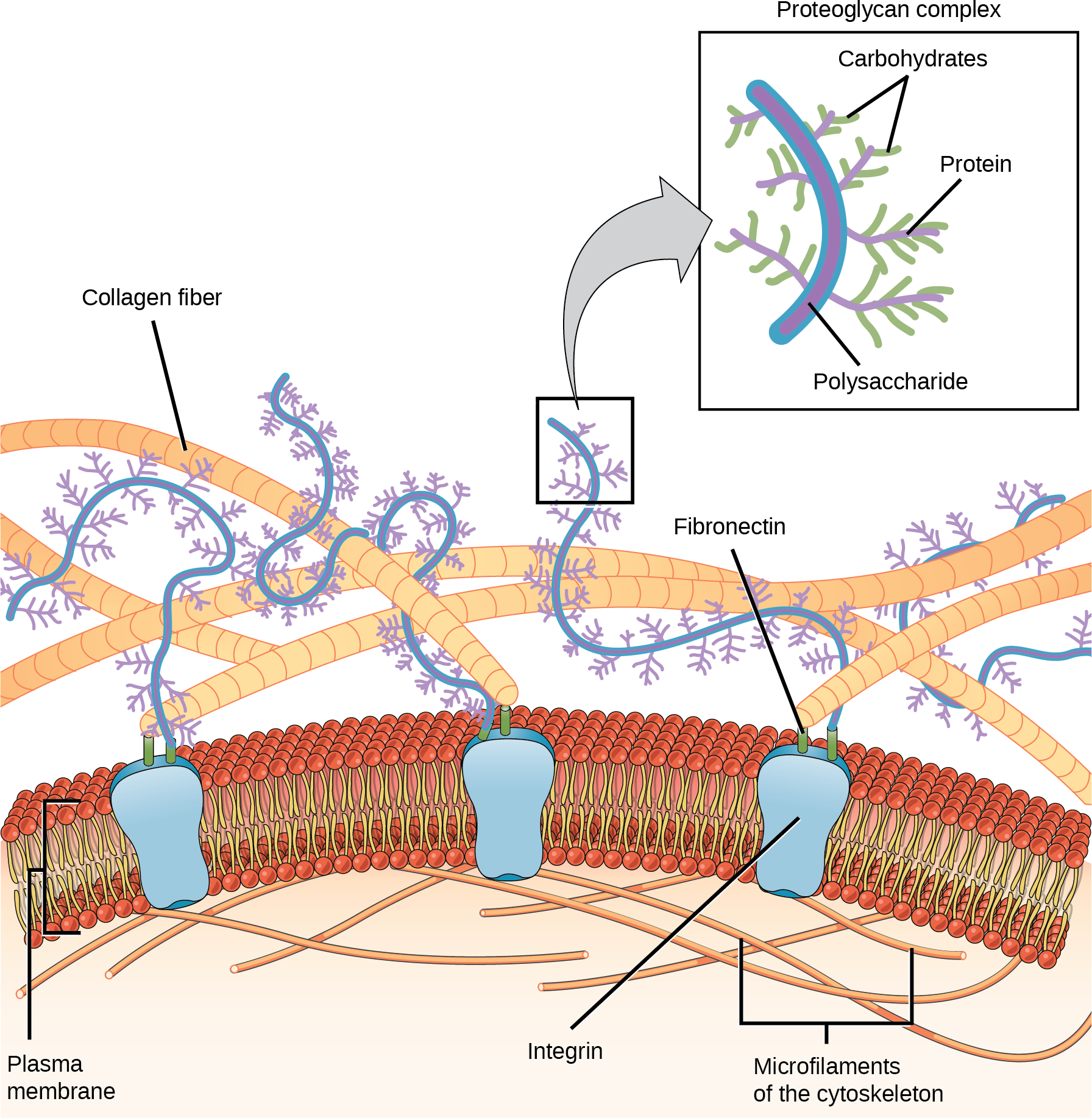
Cells have protein receptors on their plasma membranes’ extracellular surfaces. When a molecule within the matrix binds to the receptor, it changes the receptor’s molecular structure. The receptor, in turn, changes the microfilaments’ conformation positioned just inside the plasma membrane. These conformational changes induce chemical signals inside the cell that reach the nucleus and turn “on” or “off” the transcription of specific DNA sections, which affects the associated protein production, thus changing the activities within the cell.
Blood clotting provides an example of the extracellular matrix’s role in cell communication. When the cells lining a blood vessel are damaged, they display a protein receptor, which we call tissue factor. When tissue factor binds with another factor in the extracellular matrix, it causes platelets to adhere to the damaged blood vessel’s wall, stimulates the adjacent smooth muscle cells in the blood vessel to contract (thus constricting the blood vessel), and initiates a series of steps that stimulate the platelets to produce clotting factors.
Intercellular Junctions
Cells can also communicate with each other via direct contact, or intercellular junctions. There are differences in the ways that plant and animal and fungal cells communicate. Plasmodesmata are junctions between plant cells; whereas, animal cell contacts include tight junctions, gap junctions, and desmosomes.
Plasmodesmata
In general, long stretches of the plasma membranes of neighboring plant cells cannot touch one another because the cell wall that surrounds each cell separates them ((Figure)). How then, can a plant transfer water and other soil nutrients from its roots, through its stems, and to its leaves? Such transport uses the vascular tissues (xylem and phloem) primarily. There also exist structural modifications, which we call plasmodesmata (singular = plasmodesma). Numerous channels that pass between adjacent plant cells’ cell walls connect their cytoplasm, and enable transport of materials from cell to cell, and thus throughout the plant ((Figure)).
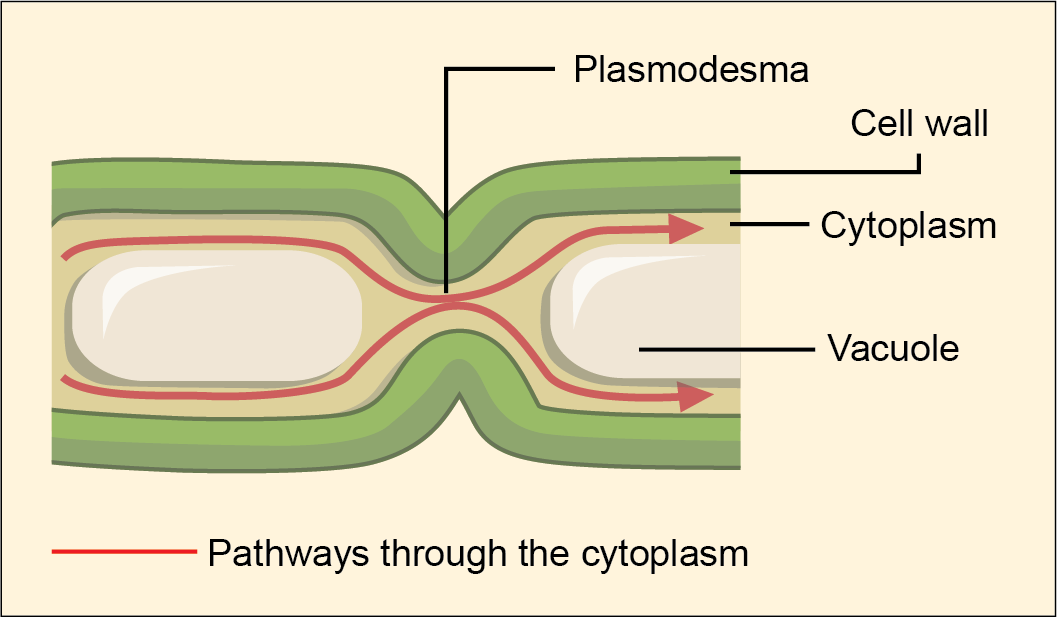
Tight Junctions
A tight junction is a watertight seal between two adjacent animal cells ((Figure)). Proteins (predominantly two proteins called claudins and occludins) tightly hold the cells against each other.
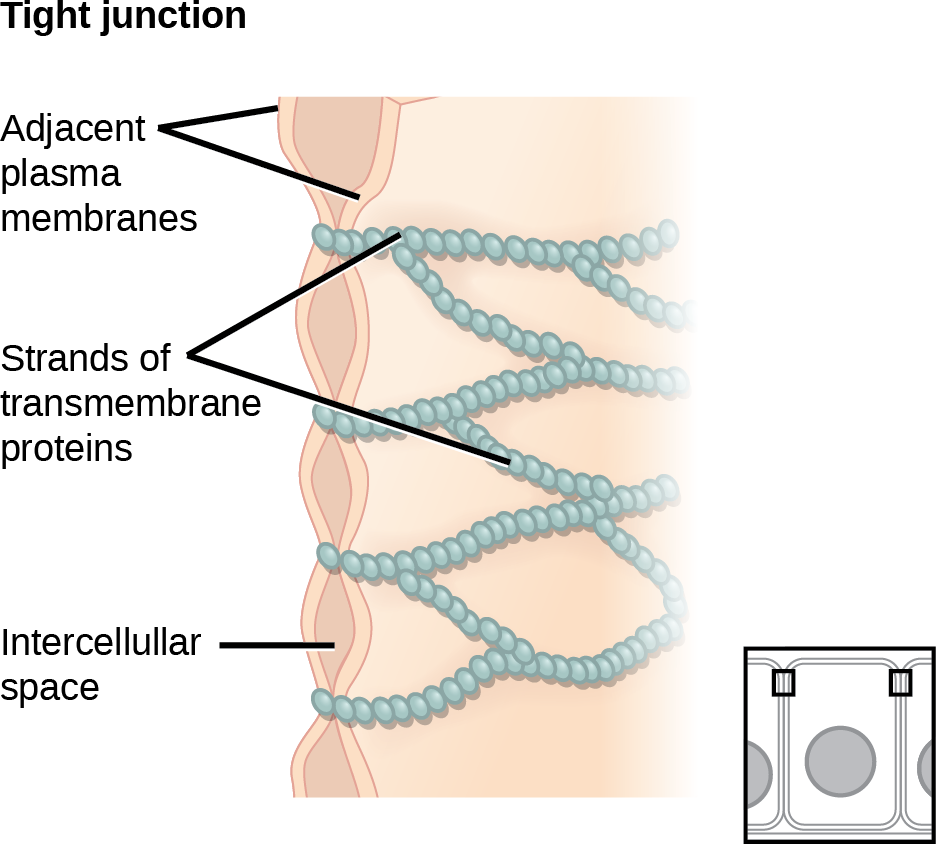
This tight adherence prevents materials from leaking between the cells; tight junctions are typically found in epithelial tissues that line internal organs and cavities, and comprise most of the skin. For example, the tight junctions of the epithelial cells lining your urinary bladder prevent urine from leaking out into the extracellular space.
Desmosomes
Also only in animal cells are desmosomes, which act like spot welds between adjacent epithelial cells ((Figure)). Cadherins, short proteins in the plasma membrane connect to intermediate filaments to create desmosomes. The cadherins connect two adjacent cells and maintain the cells in a sheet-like formation in organs and tissues that stretch, like the skin, heart, and muscles.
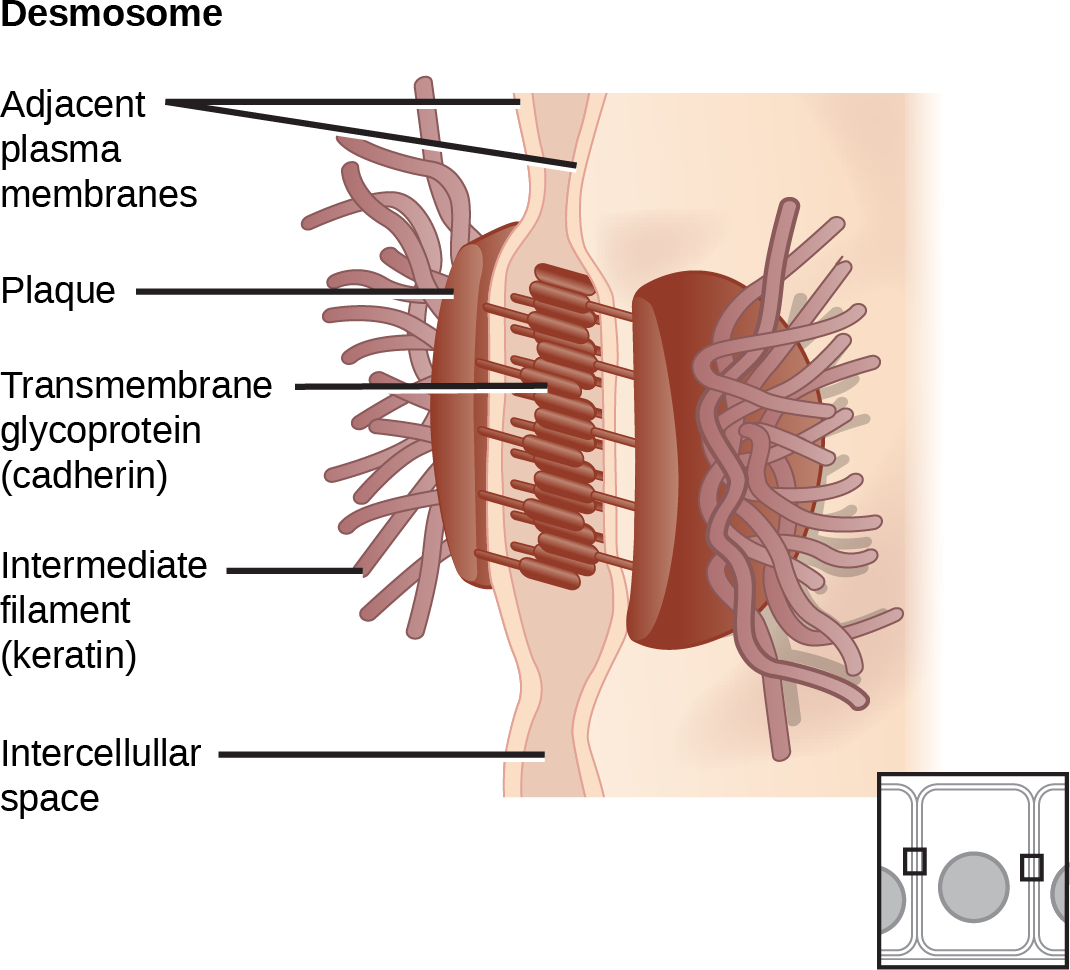
Gap Junctions
Gap junctions in animal cells are like plasmodesmata in plant cells in that they are channels between adjacent cells that allow for transporting ions, nutrients, and other substances that enable cells to communicate ((Figure)). Structurally, however, gap junctions and plasmodesmata differ.
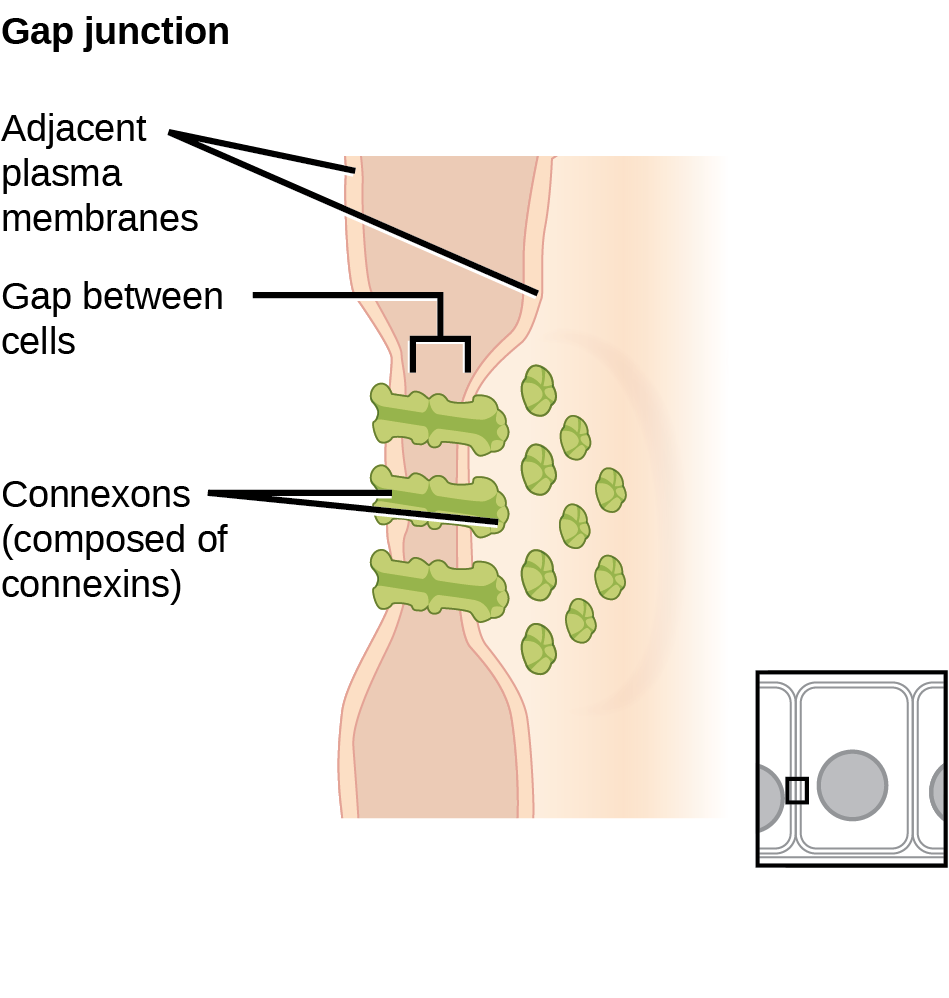
Gap junctions develop when a set of six proteins (connexins) in the plasma membrane arrange themselves in an elongated donut-like configuration – a connexon. When the connexon’s pores (“doughnut holes”) in adjacent animal cells align, a channel between the two cells forms. Gap junctions are particularly important in cardiac muscle. The electrical signal for the muscle to contract passes efficiently through gap junctions, allowing the heart muscle cells to contract in tandem.
To conduct a virtual microscopy lab and review the parts of a cell, work through the steps of this interactive assignment.
Section Summary
Animal cells communicate via their extracellular matrices and are connected to each other via tight junctions, desmosomes, and gap junctions. Plant cells are connected and communicate with each other via plasmodesmata.
When protein receptors on the plasma membrane’s surface of an animal cell bind to a substance in the extracellular matrix, a chain of reactions begins that changes activities taking place within the cell. Plasmodesmata are channels between adjacent plant cells, while gap junctions are channels between adjacent animal cells. However, their structures are quite different. A tight junction is a watertight seal between two adjacent cells, while a desmosome acts like a spot weld.
Review Questions
Which of the following are only in plant cells?
- gap junctions
- desmosomes
- plasmodesmata
- tight junctions
C
The key components of desmosomes are cadherins and __________.
- actin
- microfilaments
- intermediate filaments
- microtubules
C
Diseased animal cells may produce molecules that activate death cascades to kill the cells in a controlled manner. Why would neighboring healthy cells also die?
- The death molecule is passed through desmosomes.
- The death molecule is passed through plasmodesmata.
- The death molecule disrupts the extracellular matrix.
- The death molecule passes through gap junctions.
D
Critical Thinking Questions
How does the structure of a plasmodesma differ from that of a gap junction?
They differ because plant cell walls are rigid. Plasmodesmata, which a plant cell needs for transportation and communication, are able to allow movement of really large molecules. Gap junctions are necessary in animal cells for transportation and communication.
Explain how the extracellular matrix functions.
The extracellular matrix functions in support and attachment for animal tissues. It also functions in the healing and growth of the tissue.
Pathogenic E. coli have recently been shown to degrade tight junction proteins during infection. How would this provide an advantage to the bacteria?
E. coli infections generally cause food poisoning, meaning that the invading bacteria cross from the lumen of the gut into the rest of the body. Tight junctions hold the epithelial layer that lines the digestive tract together so that the material that crosses into the body is tightly regulated. One way E. coli can avoid this regulation is to destroy the tight junctions so that it can enter the body between the epithelial cells, rather than having to go through the cells.
Glossary
- desmosome
- linkages between adjacent epithelial cells that form when cadherins in the plasma membrane attach to intermediate filaments
- extracellular matrix
- material secreted from animal or fungal cells that provides mechanical protection and anchoring for the cells in the tissue
- gap junction
- channel between two adjacent animal cells that allows ions, nutrients, and low molecular weight substances to pass between cells, enabling the cells to communicate
- plasmodesma
- (plural = plasmodesmata) channel that passes between adjacent plant cells’ cell walls, connects their cytoplasm, and allows transporting of materials from cell to cell
- tight junction
- protein adherence that creates a firm seal between two adjacent animal cells

